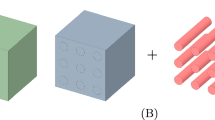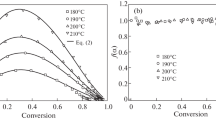Abstract
The mechanical properties and effects in fibrous composite materials are compared. The materials are based on the same matrix (EPON-828 epoxy resin) and differ in the type of fibers: Thornel-300 carbon microfibers, graphite microwhiskers, carbon zigzag nanotubes, and carbon chiral nanotubes. Two material models are considered: a model of elastic medium (macrolevel model) and a model of elastic mixture (micro-nanolevel model). Mechanical constants of 40 materials (4 types + 10 modifications) are calculated and compared. The theoretical ultimate compression strength along the fibers is discussed. The effects accompanying the propagation of longitudinal waves in the fiber direction are investigated.
Similar content being viewed by others
REFERENCES
A. N. Guz' and Ya. Ya. Rushchitskii, “Nanomaterials. Mechanics of nanomaterials,” Prikl. Mekh., 39,No. 11, 36–69 (2003).
G. Lubin (ed.), Handbook of Composites, Van Nostrand Reinhold Company, New York (1982).
H. S. Katz and J. V. Milewski (eds.), Handbook of Fillers and Reinforcements for Plastics, Van Nostrand Reinhold Company, New York (1978).
N. Wilson, K. Kannangara, G. Smith, M. Simmons, and B. Raguse, Nanotechnology. Basic Science and Emerging Technologies, Chapman & Hall, CRC, Boca Raton-London (2002).
P. J. F. Harris (ed.), Carbon Nanotubes and Related Structures, New Materials for the Twenty-First Century, Cambridge University Press, Cambridge (2000).
M. S. Dresselhaus, G. Dresselhaus, and Ph. Avouris (eds.), Carbon Nanotubes, Synthesis, Structure, Properties, and Applications, Springer-Verlag Press, Berlin (2001).
K. Lau, H. L. Li, D. S. Lim, and D. Hui, “Recent research and development on nanotube/polymer composites,” Annals Eur. Acad. Sci., 1,No. 1, 318–333 (2003).
H. S. Nalwa, Handbook of Nanostructured Materials and Nanotechnology, Academic Press, San Diego (2000).
L. J. Broutman and R. H. Krock (eds.), Composite Materials. In 8 Vols., Academic Press, New York (1974).
E. Dieulesaint et D. Royer, Ondes Elastiques dans les Solides. Aplication au Traitement du Signal, Masson et Cie, Paris (1974).
Ya. Ya. Rushchitskii and S. I. Tsurpal, Waves in Materials with Microstructure [in Russian], S. P. Timoshenko Inst. Mekh., Kiev (1998).
A. N. Guz' (ed.), Composite Mechanics. In 12 Vols. [in Russian], Naukova Dumka, Kiev (Vols. 1–4), “ASK” (Vols. 5–12) (1993–2003).
I. N. Frantsevich and D. M. Karpinos (eds.), Composite Materials of Fibrous Structure [in Russian], Naukova Dumka, Kiev (1970).
A. N. Guz', Stability of Three-Dimensional Deformable Bodies [in Russian], Naukova Dumka, Kiev (1971).
A. N. Guz', Fundamentals of the Three-Dimensional Theory of Stability of Deformable Bodies, Springer-Verlag, Berlin (1999).
A. N. Guz', “Inner instability of composites under various conditions of layer contact,” in: I. Yu. Babich (ed.), Stability of Structural Elements. Vol. 10, Ch. 6 [in Russian], (???), pp. 45–74.
A. Bedford, G. S. Drumheller, and H. J. Sutherland, “On modeling the dynamics of composite materials,” in: S. Nemat-Nasser, Mechanics Today. Vol. 3, Pergamon Press, New York (1976), pp. 1–54.
A. Bedford and G. S. Drumheller, “Theories of immiscible and structured mixtures,” Int. J. Eng. Sci., 21,No. 8, 863–960 (1983).
Ya. Ya. Rushchitskii, Elements of the Theory of Mixture [in Russian], Naukova Dumka, Kiev (1991).
Ya. Ya. Rushchitskii, “Nonlinear waves in solid mixtures (Review),” Prilk. Mekh., 33,No. 1, 3–38 (1997).
Ya. Ya. Rushchitskii, “Development of the microstructural theory of biphase mixtures with reference to composite materials,” Prikl. Mekh., 36,No. 5, 33–64 (2000).
J. J. Rushchitsky, “Interaction of waves in solid mixtures,” Appl. Mech. Rev., 52,No. 2, 35–74 (1999).
C. Cattani and J. J. Rushchitsky, “Cubically nonlinear elastic waves: wave equations and methods of analysis,” Int. Appl. Mech., 39,No. 10, 1286–1318 (2003).
Author information
Authors and Affiliations
Rights and permissions
About this article
Cite this article
Guz', I.A., Rushchitskii, Y.Y. Comparison of Mechanical Properties and Effects in Micro- and Nanocomposites with Carbon Fillers (Carbon Microfibers, Graphite Microwhiskers, and Carbon Nanotubes). Mechanics of Composite Materials 40, 179–190 (2004). https://doi.org/10.1023/B:MOCM.0000033261.29410.c1
Issue Date:
DOI: https://doi.org/10.1023/B:MOCM.0000033261.29410.c1




